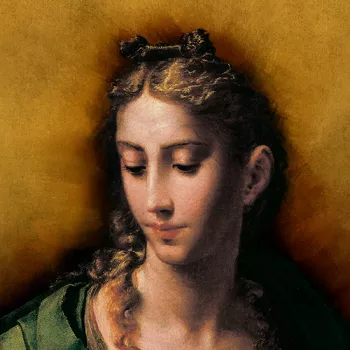Portrait of Tiziano Aspetti holding a Statuette c.1592-3
Oil on canvas | 88.0 x 67.2 cm (support, canvas/panel/stretcher external) | RCIN 405988
-
This is almost certainly a portrait of the Venetian sculptor Tiziano Aspetti, one of the leading sculptors in Venice at the end of the sixteenth century. In 1590 Aspetti and Girolamo Campagna were commissioned to carve colossal figures to flank the entrance to the Public Mint. The statuette here is probably the wax model for Aspetti’s Hercules, and the portrait may mark the completion of the work. The likeness can be compared to the later bust made for Aspetti’s tomb in the Carmine, Pisa, by his pupil, Felice Palma.
Aspetti probably trained in the family workshop in Padua and may have been the assistant of the slightly older Girolamo Campagna. In 1577 he entered the service of Giovanni Grimani, Patriarch of Aquileia, who had the most important collection of antique sculpture outside Rome. For sixteen years Aspetti had a workshop at the Grimani Palace in Venice and was responsible for restoring some of the marbles, offered to the Venetian Republic in 1589 and arranged in the Statuario Pubblico, Biblioteca Marciana, in 1596. On 3 November 1590 Aspetti and Campagna each agreed to carve a colossal marble figure to flank the entrance to the Public Mint (Zecca), directly opposite the Doge’s Palace in Venice, as part of Vincenzo Scamozzi’s extension and modification of Sansovino’s buildings. This portrait was presumably painted to celebrate the completion of this prestigious public commission in c.1592-3, a date consistent with the style of the painting.
The portrait has a directness typical of Leandro Bassano and betrays the influence of Jacopo Tintoretto’s earlier portraits, especially in the concentration of light on the face and hands. The way in which Aspetti presents his statuette to the viewer on a carpet in the Turkish style recalls the pose and setting of Veronese’s slightly earlier Portrait of a Sculptor (Metropolitan Museum, New York). As court artist to an erudite and eminent family, Aspetti appears elegantly dressed, especially in comparison with Moroni’s Alessandro Vittoria of c.1551 (Kunsthistorisches Museum, Vienna), an image of the working sculptor with rolled-up sleeves. Aspetti might even be taken for a collector, handling a prized work, like Lotto’s Andrea Odoni (Royal Collection). The only difference between sculptors and collectors in images of this kind is that the former are usually shown with a single work (the one they are ‘presenting’ to the viewer or to their patron), whereas the latter tend to be surrounded by the many riches of their collection.
The painting appears in Pyne's illustrated Royal Residences of 1819, hanging in the The King's Great Drawing Room at Kensington Palace (RCIN 922157).
Inscribed, top right: ‘LEANDER BAS / SANVS./ .F.’ (writing on the table, apparently beginning with a date, was probably once legible, but is not now).Provenance
Probably in the collection of the Mantova Benavides family and recorded by Andrea Mantova Benavides, 1695; bought by George III in 1762 with the collection of Joseph Smith, British Consul in Venice (Italian List no 278)
-
Creator(s)
Acquirer(s)
-
Medium and techniques
Oil on canvas
Measurements
88.0 x 67.2 cm (support, canvas/panel/stretcher external)
103.4 x 83.7 x 8.0 cm (frame, external)
Other number(s)
Alternative title(s)
Portrait of a man with a statuette
Girolamo Campagna (c.1530-c.1626), previously identified as
Francesco Bassano (1549-1592)?
A sculptor










